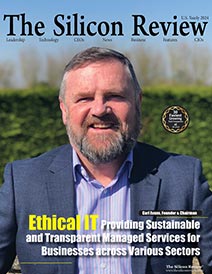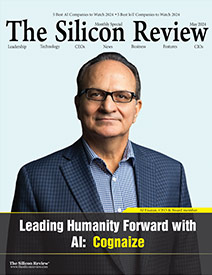Kaon Interactive’s MarTech platform drives digital sales and marketing transformation for the world’s leading B2B companies
The Silicon Review
![]()
Martech is the amalgamation of marketing and technology. The term ‘martech’ is applied to any major efforts, tools, and initiatives that will harness technology to achieve and measure marketing success. By using technology to collect and analyze data, automate, or streamline marketing processes, marketing has become a much more cost-effective function that helps in making well-informed and timely corporate decisions. As the leading innovator of 3D interactive marketing and sales applications for global B2B brands, Kaon has developed the most advanced software technology platform available to enable global companies to simplify their complex stories at every customer touch-point, both online and offline.
Kaon’s transformative sales and marketing applications enable companies to effectively communicate a product or solution’s value to prospects through interactive experiences, virtually or in-person. These interactive experiences drive increased sales effectiveness and reduced marketing costs. The digital interactive applications are created once and deployed everywhere. Available on devices running iOS, Windows, Android, and macOS, sales teams and marketers use Kaon Interactive’s solutions in nearly 150 countries. Kaon Interactive has helped visionary companies (such as Thermo Fisher Scientific, Amazon Web Services, and IBM) implement digital transformation platforms, making their transition to all virtual events and interactive engagements seamless for their sales and marketing teams. The Kaon platform, on which each of these interactive sales and marketing applications are built, creates and captures economic value at every point along the marketing and sales lifecycle. Unlike point solutions created by software vendors and agencies, Kaon’s platform’s extensible nature allows for single development and universal deployment (to unlimited users anywhere in the world and on any device). When Kaon develops an application for our customers, it is built to be device- and venue-agnostic, easily localized, and updated via the cloud in real-time, providing meaningful organizational efficiencies.
In conversation with Gavin Finn, CEO of Kaon Interactive
Q. How important is it for organizations to embrace a customer-first business model? Explain.
When you think about business strategy, especially as it relates to sales and marketing’s core functions, the best place to start is to answer the question “why.” Why is my solution important? Why would, or should someone buy from us? Leadership expert Simon Sinek presented this concept in an actionable TED Talk a couple of years ago. The point is that business leaders and strategists need to start by answering the question of “why,” rather than the what or the how (which is the easier and more commonplace to begin). Doing this forces you into your customer’s perspective: to seek their answer, to better understand your particular customer, at each point along their unique buyer’s journey. The answer to “why” leads the company to a business objective that centers on the buyer. The further away you get from the customer, the less likely you are to create a solution that will work for them. So, the more we can interact with them along the path of their purchasing decision, the better we’re going to understand their world and actually solve their problems. The only way to create sustained competitive success is to build an entire company culture focused on customer value – and then to embed this perspective into the very essence of an organization’s ethos, which must be the charge of the senior executive. Those visionary executives who embrace this kind of transformation will be the true winners of the next generation of industrial digital economies.
Q. Customer behavior is dynamic, and you have to be on your toes to understand what resonates with decision-makers, what their preferences are and how their expectations change. How do you manage this behavioral aspect of marketing?
It starts with the “why,” but it doesn’t end there. The answer continually evolves. We become comfortable with our market, business, and customers, but we should not be lured into complacency when there is always something to learn and improve. Giving the customer control plays a big part in that. When the customer feels like they are in control, they can lead the conversation and we should listen. Only by listening to our customer’s will we learn what resonates with them and their preferences and expectations. This is why Kaon’s sales and marketing applications are extensible, updatable, and feature non-linear navigation that every customer explores at their own pace. This approach has allowed each customer to spend time in the areas that are most relevant to them. Rather than listening to a sales pitch, which by definition, has to cover a whole variety of different areas of interest, they focus directly on those dimensions —product, problem, market — that is really important to them. Powerful engagement insights are included in the Kaon platform, explaining how users explore the applications – not dissimilar to website analytics but with a focus on metrics that tell a true engagement story (e.g., how long someone is ACTUALLY interacting). The B2B buying experience has, in this way, been powerfully transformed to put the customer in charge of their own journey. Thus, because of these more relevant and informative experiences, they make better buying decisions.
![]()
Q. Whether it is B2B or B2C, connecting on an emotional level is very important. How do you connect on an emotional level?
People are craving connection and seeking it out wherever they can. When we think of virtual “connections,” we typically think of connecting with other people, not content. However, we make emotional connections with content as well; we elicit emotion when we read a poem that inspires us, watch a video that makes us laugh or cry, or see a painting that transports us to a place in time or space. The key ingredient with establishing a connection with content, or a B2B interactive application, is a relevant story. Traditionally, B2B marketers err on the conservative side when it comes to their content and customer engagement strategies, whereas B2C companies are more willing to take chances. B2B buyers want to be entertained in the same way they are by consumer-focused marketing. B2B organizations can set themselves apart from the competition by embracing human-centered storytelling. People remember unusual, risky, or especially beautiful campaigns because they make connections with personal memories. These associations allow new ideas to stick and become memorable.
Q. Many enterprise organizations are still not able to change their mindset across all levels of their business to strategize and operate in digital/virtual way. What do you have to say to them?
Digital transformation has been a catchphrase in enterprise for years with varying levels of implementation and success. Equally varying is the understanding of what digital transformation means within an enterprise. Digital transformation is not a digitization of tactics and processes (putting PDFs on a website instead of printing them, for example). Digital transformation is the evolution of strategy and process facilitated by digital technology. It is a transformation of how your enterprise functions. Digital transformation has become a requirement for businesses to thrive in our current environment and beyond. The global pandemic forced the hand of enterprises that were lagging, and they found themselves at a disadvantage concerning their competitors. Robust pipelines shriveled because these companies lost the ability to engage with customers. If companies expect to not only survive but thrive through, and after this crisis, they must start to invest in digital transformation, and marketing plays a crucial role in road-mapping that process. In order to ensure continued customer success, Kaon has instituted a User Advocacy and Adoption Program that is part of our platform. We partner with customers to establish what KPIs and value are relevant for them, and then we measure digital engagement to ensure we are meeting those benchmarks. Over the long-term, our solutions deliver significantly more value than any individual point solution.
Q. Showing is better than telling. Does AR & VR technology have a significant role to play in this field?
Bain and Deloitte have identified the most important sales and marketing elements in the digital world as customer engagement. Cognitive science has shown that salespeople and marketers must connect in three ways to deliver an engaging experience.
- Intellectually, by providing relevant and useful information;
- Multisensory via touch, movement, sight, and sound; and
- Emotionally, by delighting the audience.
The key to customer engagement, I think, can be found in the Chinese proverb: “Tell me, and I’ll forget; show me and I may remember; involve me, and I’ll understand.” We have found that involving buyers in all sales process steps is crucial to their effective understanding and, consequently, closing deals. Interactive applications are a means of achieving this objective; they deliver intellectual, multisensory, and emotional experiences. Augmented reality and virtual reality can, in some cases, take these experiences to the next level by layering and enhancing the multisensory and emotional aspects of the connection, which is why we include these technologies as part of the Kaon platform. Our virtual reality applications are now available, through innovations in the Kaon platform, on any device with “non-immersive” virtual reality. However, it is critical to be strategic with these technologies and not use them as a gimmick. Augmented reality and virtual reality can be powerful and effective sales and marketing technologies when relevant and used thoughtfully.
Q. Explain the current market landscape of MarTech.
A recent study showed that chief sales and operations officers are particularly doubtful of chief marketing officers’ ability to demonstrate financial impact. According to Korn Ferry, the average tenure of a CMO is the lowest of all C-suite titles. They reported that “short CMO tenure is a reflection of a lack of understanding of how powerful this role can really be in terms of driving business outcomes.” The dramatic events of 2020 have taught us that a digital strategy for sales and marketing is no longer a “nice-to-have” for global corporations. Today’s marketing technology landscape outlined in the Chief Martec exasperating super graphic illustrates a 13.6% growth in this market in a single year. However, in an April 2nd survey, 90% of marketers reported that their budgets were frozen, delayed, or severely cut. McKinsey advises that “companies should consider quickly prioritizing and scaling new digital capabilities to enable digital touchpoints with their customers.” Their analysis also concludes that companies who “rapidly scale up their digital capabilities, and other investments are the ones most likely to come out of this crisis stronger and well positioned for the post-coronavirus recovery.” So, the question shouldn’t be about the current MarTech landscape, but what needs to change, in terms of the focus of marketing software? And the answer is digital customer engagement!
Meet the leader behind the success of Kaon Interactive
Gavin Finn is the President and CEO of Kaon Interactive, the leader in B2B interactive sales and marketing applications that transform customer engagements, accelerate B2B sales, and improve marketing effectiveness. Gavin holds both a Ph.D. and an MS from MIT and is also a Professor of the Practice at Tufts University, where he teaches Entrepreneurship, Marketing and Sales, and New Product Development.









